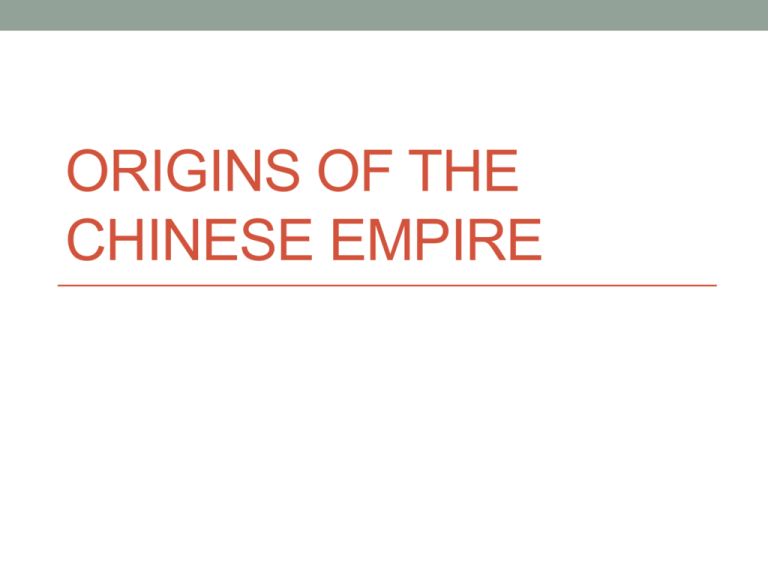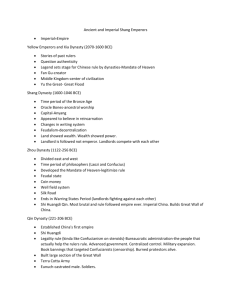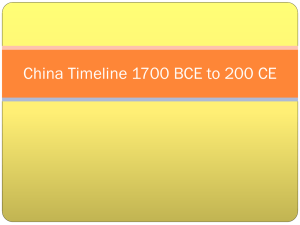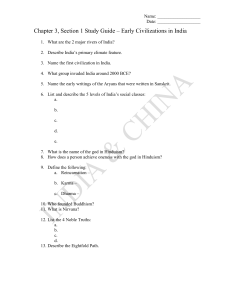AncientChina
advertisement

ORIGINS OF THE CHINESE EMPIRE Myth of China’s Origins • Set of Rulers: 1. Fu Xi – ox tamer (domesticated animals) 2. Shen Nong – divine farmer (technique of agriculture) 3. Huang Di – bows/arrows and writing • Indicate Important Characteristics of Chinese Life 1. interaction between nomadic and agricultural people 2. importance of family as basic unit of Chinese life 3. development of unique system of writing Neolithic China – river-based farming River Videos • Video #1: Yangtze River and the Three Gorges Dam • Video #2: Un-Gorgeous Three Gorges • Video #3: NYTimes Video on Yellow River, Part One • Video #4: NYTimes Video on Yellow River, Part Two Early Chinese Dynasties First Dynasty – Xia – 2200-1750 BCE • connections with Indo-Europeans: bronze, chariots, horses Second Dynasty – Shang Dynasty • (1700 BCE) – just north of Yellow River • agricultural society • urbanization & class structure developed • ruled by aristocratic warriors, city-states, tied to Shang dynasty by kinship or allegiance • believed in afterlife and ancestor worship • Best known for bronze casting • Link to MetMuseum Bronzes Xia Dynasty Jade Knife Photo by Dr. Gary Todd, Luoyang Museum Music Links • Shonta, Erhu music Shang China Rice, first cultivated in China seven or eight thousand years ago, is a labor-intensive crop that requires many workers to plant the seedlings and organize the distribution of water. Initially, the fields are flooded to facilitate the rooting of the rice seedlings and to add nutrients to the soil. Fish breeding in the flooded fields help keep mosquitoes and other insects in check. As the plants mature, the fields are drained, and the plants complete their four-month growing cycle in dry soil. Shown here is an example of terracing on a hillside to preserve water for the nourishment of young seedlings. © William J. Duiker Third Dynasty – Zhou (1122-256 BCE) • “Mandate of Heaven”: Definition?: • Duke of Zhou created tradition • Ruled with authorization of Heaven: Ruler = Son of Heaven • Required to govern justly and humanely • Heaven would withdraw support if he abused people and give support to someone else, starting a new dynasty • Started dynastic cycle: rise of one dynasty, loss of mandate, overthrown, new dynasty,…and so on • Kings selected based on “talent and virtue” (although hereditary) • Trade/monetary system – new cities, trade networks, roads, canals, copper coins (‘cash’) Western Zhou Bronze Photo by Dr. Gary Todd, Luoyang Museum Qin Dynasty – (221 – 206 BCE) • Started by Shihuangdi • Centralized State Powers (3 primary ministries) • civil authority • military • censorate • Power based on legalist ideas: dictating laws to people • Successes: • Standardized system of weights and measures • Standardized system of writing and money • Constructed roads • Government controlled trade • Terracotta warriors and tomb; started Great Wall • Abuse of power, so son overthrown by Han dynasty The Tomb of Qin Shi Huangdi The First Emperor of Qin ordered the construction of an elaborate mausoleum, an underground palace complex protected by an army of terra-cotta soldiers and horses to accompany him on his journey to the afterlife. Video Link: David Brenneman Reporting Video Link: NatGeo Terra Cotta Warriors © William J. Duiker The First Emperor of Qin ordered the construction of an elaborate mausoleum, an underground palace complex protected by an army of terra-cotta soldiers and horses to accompany him on his journey to the afterlife. This massive formation of six thousand life-size armed soldiers, discovered accidentally by farmers in 1974, reflects Qin Shi Huangdi’s grandeur and power. © Martin Puddy/Getty Images The Great Wall Great Wall construction began in defense against the Xiongnu – invaders from north • Info on the Great Wall • GoogleMaps of Great Wall Link to Wikipedia Map of Great Wall The Han Dynasty – (202 BCE – 220 CE) • First Emperor – Gaozu • No more legalism – State Confucianism • government officials selected by merit • Population increased rapidly • State regulated trade and manufacturing • The Silk Road • New technologies: textiles, water and iron • Paper was invented • Dynasty so successful that Chinese people today still call themselves the Han people The Silk Road • Trade route from China to • Silkworm growth western Asia, Africa, and Europe • All kinds of goods, including Chinese silk stages video • Making Silk video • Silk Road video Western Han Pottery, female figure Photo by Dr. Gary Todd, Luoyang Museum Han Jade Disc Photo by Dr. Gary Todd, Luoyang Museum Eastern Han Pottery Chandelier Photo by Dr. Gary Todd, Luoyang Museum Chinese Philosophies and Religions Ancient Religion and World View • World divided into 3 levels: heaven, earth, underworld • Reverence for ancestors – link between past, present, • • • • • and future Devotion and sacrifices to ancestors at shrines – in home, temples, or nature 2 souls: hun (heaven; spirit); po (with corpse; ghost) Devotion = prosperity Divination – shamans or priests use techniques to understand supernatural or spirit world (oracle bones) These beliefs and practices could be combined with other religious or philosophical beliefs/practices Shell and Bone Writing The earliest known form of true writing in China dates back to the Shang dynasty and was inscribed on shells or animal bones. Questions for the gods were scratched on bones, which cracked after being exposed to fire. The cracks were then interpreted by sorcerers. The questions often expressed practical concerns: Will it rain? Will the king be victorious in battle? Will he recover from his illness? Originally composed of pictographs and ideographs four thousand years ago, Chinese writing has evolved into an elaborate set of symbols that combine meaning and pronunciation in a single character. © Werner Forman/Art Resource, NY Oracle Bone. China, Shang Dynasty, ca. 1300-1050 BCE. Scapula, (11.4 cm. x 18 cm.) C. V. Starr East Asian Library, Columbia University Link to Lesson on Oracle Bones, British Museum Burial goods in tombs prove belief in the afterlife Like the pharaohs in Egypt, Chinese rulers filled their tombs with prized possessions from daily life. It was believed that if the tombs were furnished and stocked with supplies, including chairs, boats, chests, weapons, games, and dishes, the spiritual body could continue its life despite the death of the physical body. Here we see the remains of a chariot and horses in a burial pit in China’s Hebei province that dates from the early Zhou dynasty. © Lowell Georgia/CORBIS Confucianism • Confucius (Kungfuzi) – 551-479 BCE • Analects – written conversations with disciples • Emphasis on honorable, “noble-minded” public service: “You are unable to serve man, how then can you hope to serve the spirits? While you do not know life, how then can you know about death?” • Focus on active public life (compared to Daoism) • Could be conservative (stay in place, obey) or radical (question authority, expect just rule, overthrow unjust) • Virtual Confucius Exhibit, China Institute, NYC Confucius and his disciples © Howard Sochurek/Time & Life Pictures/Getty Images Daoism (Taoism) • Laozi – legendary figure, 6th-century BCE • Main text, Daodejing • Dao (The Way) – action/behavior • Live in harmony with nature • Let go of control • Avoid worldly ambition • Silence, passivity, contemplation: “True way to interpret the Will of Heaven is not action, but inaction.” • Much different than Confucianism – more about private thought and living Laozi – legendary founder and Daoist philosopher Yin and Yang • Harmony of opposites • Light and dark • Sun and moon • Male and female • Confucianism (public politics) and Daoism (private thought) Legalism • Based on ideas of Xunzi – 300-230 BCE • Responded to disorder of warring states • Believed humans were selfish and brutal • Order had to be imposed from above • Strict laws enforced by powerful authoritarian state • Disciple Li Si advised Qin ruler (terracotta warriors, Great Wall) – short-lived brutal dynasty Integrating Various Beliefs • Question: In your view, how can one person integrate various Chinese beliefs and philosophies in his/her daily life without seeing a conflict between them? • Open book quiz – one paragraph to answer the question: • Give topic sentence • Then outline the rest of the paragraph (give basic info. to back up your topic sentence; info. doesn’t have to be in complete sentences) • No citations necessary









